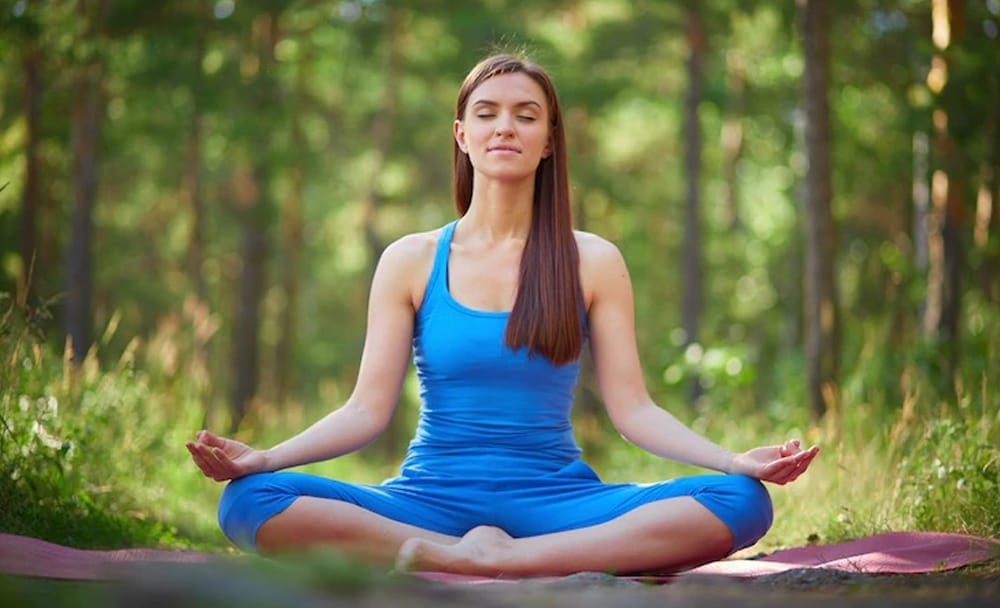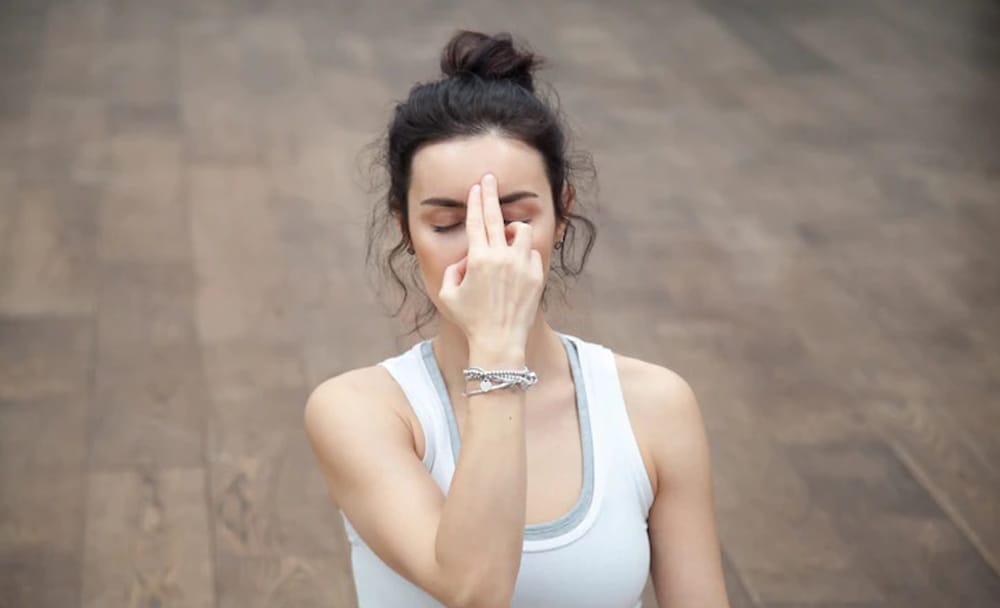Pranayamas are breathing exercises and techniques that help achieve physical and mental wellness. In Sanskrit, Prana means life energy, and Yama means control, thereby signifying the true purpose of Pranayama.
They are one of the main components of Yoga and are considered essential for good meditation. There are different types of pranayama. Each Pranayama offers specific therapeutic pranayama benefits.
However, the main objective of these breathing exercises is to connect your body and mind and remove accumulated toxins.
The technique within the various types of Pranayama also varies. However, all types of pranayama focus on four parts of breath: inhalation (Puraka), internal retention (Antara-Kumbhaka), exhalation (Rechaka), and external retention (Bahya-Khumbaka). These four steps if undertaken correctly can give you an answer to the question, ‘What are the benefits of pranayama’. Read on to learn about the types of pranayama and its benefits:
Types of Pranayama With Their Benefits
-
Ujjayi Pranayama
Also known as Ocean or Victory Breath, Ujjayi Pranayama signifies victory from bondage. These pranayama benefits include deeper breathing that is fuller and longer. It is known to bring stability to the body and mind.
How to Do?
To practice Ujjayi Pranayama, constrict the back of your throat slightly and take deep and long breaths instead of shallow breaths. Then, produce frictional sounds with vibrations from the back of your throat while exhaling from the nose. Repeat this process a few times.
Ujjayi Pranayama Benefits
- Treats throat, cough, and other respiratory problems
- Boosts the functioning of the nervous system
- Relieves stress and anger
- Helps in meditation
- Purifies subtle Nadis
- Improves immunity
- Detoxifies internal organs
2. Nadi Shodhana Pranayama
In Sanskrit, Nadi means subtle energy channels, Shodhana means cleansing or purification, and Pranayama means breathing technique. Hence, Nadi Shodhana Pranayama, or alternate nostril breathing is a Yogic breathing technique to cleanse and balance the two most important Nadis or energy channels, namely Ida and Pingala. These Nadis, in turn, stimulate the central channel called Sushumna Nadi and restore the balance of the two hemispheres of the brain.
How to Do?
To practice Nadi Shodhana, one of the most important types of pranayama, close the right nostril with your right thumb and inhale deeply from your left nostril. Hold your breath for a few seconds, and then gently release your thumb. Next, close the left nostril with the ring finger of your right hand and exhale slowly from your right nostril. This time, inhale deeply from the right nostril and exhale from the left one. Repeat this process a few times.
Nadi Shodhana Benefits
- Purifies and balances Ida and Pingala Nadi
- Balances the right and left hemispheres of the brain
- Improves sleep
- Boosts nervous system
- Enhances focus and concentration
- Improves respiratory functions
- Aids in meditation
3. Kapalabhati Pranayama
In Sanskrit, Kapal means skull, and Bhati means light. Therefore, Kapalbhati is also often called Skull Shining Breath. This Pranayama involves exhalation through strong and fast abdominal contractions. The pranayama meditation benefits for Kapalabhati include cleansing the breathing pathways.
How to Do?
Take a long inhale and exhale forcefully through your nostrils while pulling your stomach in towards the spine. Then, loosen your stomach so that you automatically inhale the air again. Repeat this process a few times.
Kapalbhati Pranayama Benefits
- Improves blood circulation in the body
- Increases and stimulates the digestive fire or Agni
- Strengthens and tones the abdominal muscles
- Aids in losing weight
- Reduces blood sugar levels
- Treats respiratory disorders such as cold, cough and asthma
- Reduces stress
- Detoxifies the body and improves the health of internal organs
4. Bhastrika Pranayama
Also known as Bellows Breath or Breath of Fire, Bhastrika Pranayama is a forceful breathing technique that helps Prana gush into your system. It focuses on both inhalation and exhalation and helps to detoxify and energize the body.
How To Do?
Inhale deeply and then forcefully exhale the air with a nasal or hissing sound. With the same force, inhale the air again and expand your chest and abdomen region. Repeat this process a few times.
Bhastrika Pranayama Benefits
- Detoxifies the body
- Provides energy to the body and mind
- Balances all the three Doshas
- Tones down abdominal muscles
- Boosts the digestive system
- Balances nervous system
- Aids in meditation
- Improves the health of the respiratory system
5. Bhramari Pranayama
Also known as Bumblebee Breath, Bhramari Pranayama is a breathing technique that uses sound and breath to calm the mind and nervous system. It is highly beneficial for students and people who do intense brainwork.
How to Do?
To practice Bhramari Pranayama, gently press your right ear cartilage with your right index finger and your left ear cartilage with your left index finger. You may also place the rest of your fingers on your forehead and eyes. Next, inhale deeply and exhale while making a steady and low-pitched humming sound from the back of your throat. Repeat this process a few times, and then gently open your eyes.
Bhramari Pranayama Benefits
- Reduces stress and anxiety
- Improves concentration and brain
- Cures headaches and migraines
- Improves sleep
- Controls hypertension
- Helps in meditation
6. Dirga Pranayama
Also called Three-Part Breath, this is a yogic breathing technique that encourages full oxygen exchange, enhances lung capacity, and promotes relaxation. By engaging the diaphragm fully, it stimulates the parasympathetic nervous system, aiding in stress reduction.
How to do?
Assume a supine position or find a comfortable seat. Inhale and exhale naturally to initiate relaxation in your body. Gradually take a deliberate, unhurried deep breath, sensing it expands your abdominal area. Notice its progression, extending to inflate the chest area, and eventually reaching the neck region. Once your breath reaches its fullest point, commence a gradual exhalation in the opposite sequence. Observe the air departing from your neck, followed by your chest, and concluding with the abdominal region. Repeat this sequence for the next 10 to 20 breath cycles.
Dirga Pranayama benefits
- A fundamental step for those new to pranayama
- Fosters mindfulness of breath
- Calms the mind and readies it for meditation
- Improves focus and concentration
- Helps induce better sleep
- Helpful for better skin and hair quality
7. Anuloma Viloma Pranayama
Commonly known as Alternate Nostril Breathing, this yoga posture involves controlled inhalation and exhalation through each nostril. It balances energy channels, enhances breath awareness, and promotes relaxation. Using the thumb and fingers, you alternate nostrils while breathing.
How to do?
Assume the pranayama posture. Breathe out through both nostrils. Shut the right nostril, and breathe in through the left for 4 counts. Close the left nostril. Hold for 16 counts. Open the right nostril, and exhale for 8 counts. Mirror this when inhaling through the right nostril. Repeat these steps for 5 rounds.
Benefits of Anuloma Viloma Pranayama
- Improves the health of the eyes, skin, and cardiovascular system
- Facilitates improved respiratory function and heals heal respiratory issues like asthma and bronchitis
- Induces a calmer mind
- Alleviate depression, stress, and anxiety
- Alleviate serious health issues such as severe depression, high blood pressure, arthritis, and migraine pain
- Counters negative thoughts, promoting positive thinking
- Helps overcome emotions like anger, forgetfulness, uneasiness, and frustrations
8. Surya bhedana pranayama
Surya Bhedana Pranayama, known as Solar Piercing Breath involves right nostril breathing. This practice is believed to awaken the kundalini Shakthi and stimulate energy and warmth, activating the sympathetic nervous system.
How to do?
Assume a comfortable seated position. Seal your left nostril. Inhale leisurely, filling your lungs completely. Close the right nostril, holding your breath for 10 to 15 counts. Release the right nostril and exhale through it. Repeat this sequence at your ease until you feel accustomed.
Benefits of Surya bhedana pranayama
- Engaging in this practice prior to meals enhances the digestion process.
- Effective for Vata-related concerns
- Revitalizes blood oxygen levels
- Revitalizes the body’s energy
- Eradicates all ailments arising from inadequate oxygen in the bloodstream
- Eradicates decay and mortality
- Stimulate Kundalini Shakti
- Augments the digestive vigor
- Purifies the frontal sinuses
- Mitigates Vata-related issues
- Combats intestinal worms
9. Sitkari Pranayama
In this pranayama, you inhale through the mouth with a hissing sound, usually between the teeth. This practice has a cooling and calming effect on the body and mind. The air passing through the wet tongue provides a refreshing sensation. Sitkari Pranayama is particularly beneficial during hot weather or when seeking to pacify Pitta dosha in Ayurveda.
How to do?
Take a relaxed posture. Gently part your upper and lower teeth, keeping the mouth open. Inhale gradually through the spaces between the teeth. Experience the refreshing sensation of the air as it fills the chest and abdomen. Shut your mouth and exhale through your nostrils. Repeat this process for a range of 10 to 20 repetitions.
Benefits of Sitkari Pranayama
- Has a calming influence on the nervous system
- Diminishes surplus bile production
- Mitigates fever
- Regulates appetite and quenches thirst
- Diminishes stress
- Induces relaxation in both body and mind
- Assists in reducing blood pressure
- Aids individuals grappling with insomnia
10. Simhasana Pranayama
This pranayama is known as Lion’s Breath and involves a distinctive breathing technique combined with a yoga pose. It helps release tension, promotes facial relaxation, and stimulates the throat muscles of the entire face, along with the jaw and tongue. It is often employed for its therapeutic effects on the thyroid and vocal cords.
How to do?
Sit in a comfortable position. Inhale using your nostrils, then exhale audibly, producing a “ha” sound. During exhalation, widen your mouth fully, extending your tongue towards your chin. Inhale and release any facial tension. Repeat this sequence for a total of 20 repetitions.
Benefits of Simhasana Pranayama
- Aids in the prevention and control of thyroid-related concerns
- Relieves tension in the chest and face
- Activates the platysma, a flat, rectangular muscle positioned in the front of the throat
- Helps maintain the firmness of the platysma with age
- Counteracts ailments and facilitates the three key bandhas (Mula, Jalandhara, Uddiyana).
FAQs on Pranayama
1. What are the three main advantages of practicing pranayama?
There are a variety of psychological advantages linked to Pranayama. Three of the most beneficial ones are enhanced emotional reactions, reduced fatigue and stress, and decreased anxiety in individuals dealing with cancer or cardiovascular issues.
2. Which Pranayama is believed to hold the highest potency?
Bhastrika Pranayama is considered to have the technique of utmost power in pranayama.
“Bhastrika” can be understood as “Bellows,” which refers to a device utilized for generating a forceful burst of air, often employed to stoke a fire. During the execution of this yogic method, you imitate analogous movements akin to those of bellows. Furthermore, this practice generates warmth within the sacral region and the pelvic floor, akin to kindling the embers of your dormant vitality.
3. What are the three phases of pranayama?
The initial phase of inhalation is known as Puraka, while the final phase of exhalation is referred to as Rechaka. The pause in between, where the breath is held, is termed Bahya Kumbhaka. The breath pattern follows a ratio of 1:2:3.
Takeaway
There are many types of Pranayama, some of which are listed above. The technique for each Pranayama is different and so are the benefits offered by them. However, the goal of all types of Pranayama is to remove harmful toxins from your body and establish a connection between your body and mind. These breathing exercises help promote relaxation and mindfulness while also boosting your physical health.



















